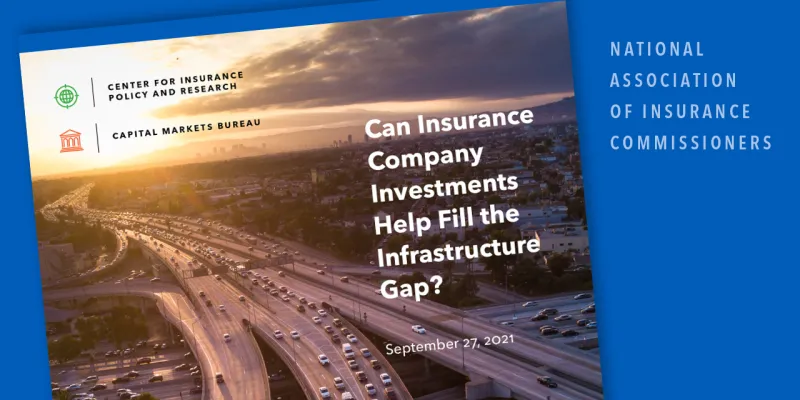
NAIC Report Highlights U.S. Insurance Sector’s Potential to Help Fill the Infrastructure Investment Gap
The National Association of Insurance Commissioners’ (NAIC) Center for Insurance Policy & Research (CIPR) and Capital Markets Bureau today released their joint report - Can Insurance Company Investments Help Fill the Infrastructure Gap? The report establishes a baseline understanding of infrastructure investment by the U.S. insurance industry (size and performance) and subsequently investigates the industry’s potential for helping close the infrastructure gap.
Recent analysis suggests the United States is not “making the grade” when it comes to infrastructure, having earned a C- on the 2021 Report Card on American Infrastructure produced by the American Society of Civil Engineers (ASCE). Although progress has been made in the past few years, a substantial gap exists between the infrastructure investment necessary to support continued economic vigor and growth and what is currently financed and projected to be financed in the near term.
In the United States, the ASCE estimates the funding gap to be nearly $2.6 trillion over the next 10 years. Further, at current rates of U.S. infrastructure investment, the ASCE projects this gap to cost the United States $10 trillion in aggregate forgone gross domestic product, more than 3 million jobs, and $2.4 trillion in exports through 2039.
The report emphasizes that evaluating the suitability of infrastructure investments for insurance companies cannot compromise the core mission of insurance regulators to preserve the solvency of regulated insurance companies and to protect policyholders.
Significant Findings in the Report Include:
- The report offers a uniform definition of infrastructure that could be used as a basis for discussions around financial investments in infrastructure within the insurance industry: generally, economic infrastructure is long-lived, capital-intensive, large physical assets that provide essential services or facilities to some jurisdiction.
- Using NAIC data, as well as other supplemental sources, findings estimate total U.S. insurance industry exposure to economic infrastructure to be roughly $570.5 billion by NAIC’s definition.
- Infrastructure investments have many qualities that should be appealing to insurers, potentially well-positioning them to make additional infrastructure investments under the right circumstances. For example, historical performance data from S&P Global Ratings and Moody’s Investors Services show that:
- municipal bonds backing infrastructure outperform infrastructure bonds issued outside of the public sector.
- corporate infrastructure debt outperforms all non-financial corporate debt (which includes infrastructure). Superior performance is evident across the performance metrics we assessed, including default rates, recovery rates given default, and rating migration.
About the National Association of Insurance Commissioners
As part of our state-based system of insurance regulation in the United States, the National Association of Insurance Commissioners (NAIC) provides expertise, data, and analysis for insurance commissioners to effectively regulate the industry and protect consumers. The U.S. standard-setting organization is governed by the chief insurance regulators from the 50 states, the District of Columbia and five U.S. territories. Through the NAIC, state insurance regulators establish standards and best practices, conduct peer reviews, and coordinate regulatory oversight. NAIC staff supports these efforts and represents the collective views of state regulators domestically and internationally.
